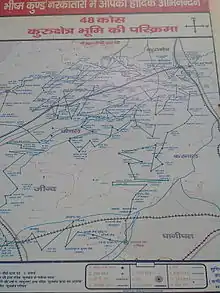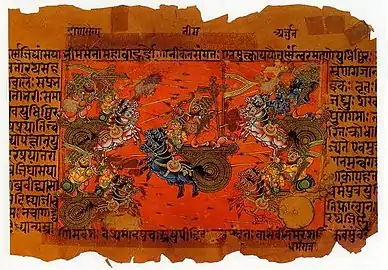48 kos parikrama of Kurukshetra
48 kos parikrama is a Hindi phrase meaning a 48 kos circumambulation parikrama (pilgrimage) of various Mahabharata-related and other vedic era tirthas (Hindu sacred sites) around the holy city of Kurukshetra in the state of Haryana, India.[1][2][3][4] There are several pilgrimages around the city of kurukshetra and a complete parikrama means to visit all these pilgrimages. The picture depicts the complete map of all these sites.

Since this is a site associated with the vedic era Lord Krishna and mahabharata, it is an important place of pilgrimage for Hindus. It is one of 3 main pilgrimage sites related to "Krishna" circuit, namely "48 kos parikrama of Kurukshetra" in Haryana, "Braj parikarma" in Mathura in Uttar Pradesh state and "Dwarka parkarma" (Dwarkadish yatra) at Dwarkadhish Temple in Gujarat state.
Main sites
Hindu and Jain pilgrimage
Lord Krishna, Kaurava and Pandava visited and lived in this area, and it is revered as their Karma Bhūmi (most sacred land of virtuous deeds) also related to the five classical elements of Hinduism called Pancha Tattva. Brahma Sarovar is the focal site of this circuit, which can be subdivided into various other itineraries.
Within Kurukshetra, along with Brahma Sarovar, other important sites are Jyotisar (place of "Gitaupadesha" - the first Upadeśa or discourse of Bhagavad Gita by Lord Krishna)[5][6] and Sannihit Sarovar (Hindu genealogy registers of Kurukshetra are kept here).[7] Pilgrims also visit the Bhishama kund, Surya kund and Sthaneshwar Mahadev Temple (where Pandavas along with Krishna prayed to Shiva and received his blessings for victory in the battle of Mahabharata)[8][9]
In addition, pilgrims also visit Pehowa, where the most revered sites are Saraswati tirtha and Prithudak tirtha, which is an ancient city and its religious significance is mentioned in several puranas, such as Skanda Purana (1st to 5th century CE), Markandeya Purana (4th to 6th century CE) and Vamana Purana (5th to 11th century CE).[10]
In Yamunanagar district, Kapal Mochan (Kapal Mochan (visited by Lord Rama)[11] and Sri Sarasvati Udgam Tirath at Adi Badri (place where deified mother goddess Sarasvati is revered because the sacred Sarasvati River enters the plains from the foothills of shivalik range) are also important sacred sites.
Many pilgrims like to trace their genealogy going back hundreds of generation, trace prior visits by their ancestors and record their own visit in the Hindu genealogy registers of Kurukshetra and Hindu genealogy registers of Pehowa maintained by Pandas (professional genealogists).[12][13][14]
- List of most important sacred sites
- Kurukshetra: Brahma Sarovar, Sthaneshwar Mahadev Temple, Sannihit Sarovar, Jyotisar, Hindu genealogy registers of Kurukshetra
- Pehowa: Saraswati tirtha and Prithudak tirtha
- Yamunanagar district: Kapal Mochan and Adi Badri
Buddhist pilgrimage
Buddha had visited Sthaneshwar and gave discourse on the banks of Brahma Sarovar where a Bodh Stupa was built.[15] Stupa has five structures of brunt brick, first three from Kushana period, 4th from Gupta period, and the last from Verdana period and later medieval period. During Harshavardhana reign, a 3 meters wide compound wall was built.[15]
For the Buddhist pilgrims, the most important sites are Brahma Sarovar and the Bodh Stupa on its northwestern flank. Other Buddhist pilgrimage sites nearby Buddhist sites include Chaneti, Topra, and Adi Badri Sharirika stupa. Many pilgrims prefer to follow the path taken by Buddha along Grand Trunk Road in Haryana. Stupas, pagodas and places in the order of travel by Lord Buddha are:
- From Mathura in Uttar Pradesh, Buddha travelled along Grand Trunk Road in Haryana (also see Buddhist pilgrimage sites in Haryana).
- Kamashpura Aastha Pugdal Pagoda (Kumashpur) in Sonipat city, the place where Buddha gave Mahasatipatthana sutta.[16][17]
- Assandh Kushan stupa at Assandh in Karnal district
- Kurukshetra Stupa on the banks of sacred Brahma Sarovar in Kurukshetra city was also visited by Hieun Tsang,[15]
- Topra between Kurukshetra and Yamunanagar, now has a large open air museum park housing several replica of Ashoka's edicts including largest Ashoka Chakra in the world,[18][19] original site of Ashokan pillar which was moved to Feroz Shah Kotla in Delhi in 1356 CE by Firuz Shah Tughlaq.[20]
- Srughna, now known as the Sugh Ancient Mound, on outskirts of Yamunanagar city
- Chaneti Buddhist Stupa, on outskirts of Yamunanagar city, according to Hieun Tsang it was built by the King Ashoka.[21][22][23]
Sikh pilgrimage
Several Sikh gurus had visited Sthaneshwar, Pehowa and Kapal Mochan for the holy dip.
In Kurukshetra, Sikh pilgrims visit Brahma Sarovar and the "Gurudawara Pehli Patshai" (just next to Sthaneshwar Mahadev Temple on the south bank of Brahma Sarovar where the ninth Guru Tegh Bahadur stayed at). Following the trail of Sikh gurus, the pilgrims also visit Pehowa as well as Kapal Mochan. Kapal Mochan was visited by Guru Nanak and Guru Gobind Singh after Battle of Bhangani in 1688 CE.[24][25]
Other important Sikh pilgrimage sites are Sadaura, Lohgarh (capital of Banda Singh Bahadur)[26] and Badkhalsa in Sonipat (where Bhai Kushal offered his head to retrieve Guru Teg Bhadur's head beheaded by mughals so that it can be taken to Anandpur Sahib}.[27][28]
List of pilgrimage sites in 48 kos parikrama
Some of the pilgrimages are listed below:[29]
Tirthas of Kurukshetra district
|
1. Arunai tirtha, Arunai |
12. Bhadrakali Temple, Kurukshetra |
22. Bhurishrava Tirtha, Bhor Saidan
|
Tirthas of Jind district
|
32. Bhuteshwar tirtha, Jind |
38. Varahakalan tirtha, Brahakalan |
44. Sarpadaman tirtha, Safindon |
Tirthas of Panipat district
50. Tarntauk Yaksha, Sinkh
Tirthas of Kaithal district
|
51. Pawanhrad tirtha, Pabnawa |
68. Vishnupada tirtha, Barsana |
85. Sringi Rishi tirtha/ Shankhni Devi tirtha, Sangan |
Tirthas of Karnal district
|
101. Vedvati tirtha, Sitamai |
113. Parashar tirtha, Bahalolpur |
124. Brahma tirtha, Rasalwa |
See also
- Krishna related pilgrimages
- Other religious
- Adi Badri, Haryana
- Dhosi Hill
- Kapal Mochan
- Hindu pilgrimage sites in India
- Famous Hindu yatras
- List of Hindu festivals
- Padayatra
- Ratha Yatra
- Tirtha
- Tirtha and Kshetra
- Vedic era
References
- "Kurukshetra map". kurukshetra.nic.in. Archived from the original on 25 June 2016. Retrieved 24 July 2016.
- "Haryana Tourism". Retrieved 24 July 2016.
- "Development of all pilgrimage sites located within a radius of 48 kos (miles) of Kurukshetra would be carried out". Chief Minister's Office, Haryana. 11 October 2015. Retrieved 24 July 2016.
- "The 48 Kos Kurukshetra Region". harekrsna.com. Retrieved 24 July 2016.
- Jyotisar Kurukshetra district website.
- "Jyotisar". Haryana Tourism Corporation Limited. Retrieved 8 August 2014.
- "Tirath in Kurukshetra - Sannehit Sarovar". Kurukshetra district website. Retrieved 8 August 2014.
- Dev Prasad (2010). Krishna: A Journey through the Lands & Legends of Krishna. Jaico Publishing House. pp. 216–. ISBN 978-81-8495-170-7.
- "Religious Places in Kurukshetra: Sthaneswar Mahadev Mandir". Kurukshetra District website. Retrieved 8 August 2014.
- Kurukshetra Development Board can get the responsibility of Saraswati Tirtha, Dainik Jagran, 4 Feb 2019.
- yamunanagar.nic.in: History of Kapal Mochan
- Tracing your Asian roots Archived 26 April 2017 at the Wayback Machine www.overseasindian.in.
- Hindu Pilgrimage Marriage Records www.movinghere.org.uk.
- 10 Places Across The World That Help You Trace Your Ancestors, India Times, 29 Jan 2016.
- "Buddhist Stupa At Kurukshetra". The Buddhist Forum. 31 March 2012. Retrieved 20 December 2018.
- Dhamma patthana, dhamma.org.
- Aastha Pugdal Pagoda at Kumaspur (Kamas Nigam in Sonepat, SDBST.
- Khattar announces Rs100 cr to develop Saraswati, Topra Kalan, The Tribune, 11-Apr-2015
- Park for Ashoka stalled?, DNA India News, 7-Nov-2016
- HM Elliot & John Dawson (1871), Tarikh I Ferozi Shahi - Records of Court Historian Sams-i-Siraj The History of India, as Told by Its Own Historians, Volume 3, Cornell University Archives, pp 352-353
- Corporation, Haryana Tourism. "Buddhist Stupa Chaneti - Places of interest - Yamuna Nagar - Haryana Tourism Corporation Limited". destination. Retrieved 25 August 2019.
- "Buddhist Stupa, Chaneti, Yamunanagar (Buddhist Stupa), circa 3rd Century BC" (PDF).
- "Buddhist Stupa At Chaneti". The Buddhist Forum. 31 March 2012. Retrieved 25 August 2019.
- G.S., Randhir (1990). Sikh shrines in India. New Delhi: The Director of Publication Division, Ministry of Information and Broadcasting, Government of India. pp. 42–43.
- Charitar 71, Charitar of Kapal Mochan, Charitropakhyan, Dasam Granth, Guru Gobind Singh
- singh, Dr. Ganda (1964). Banda Singh Bahadur(in Punjabi. Sikh Itihaas Research Board, SGPC, AMRITSAR.
- Pioneer, The. "CM unveils statue of Kushal Singh Dahiya". The Pioneer. Retrieved 27 November 2018.
- Singh, Darshan (2003). Martyrdom of Guru Tegh Bahadur. Anamika Publishers & Distributors. ISBN 9788179750322.
- "Tirthas of dist. Kurukshetra" (PDF). kurukshetra.nic.in. Archived from the original (PDF) on 5 March 2017. Retrieved 24 July 2016.

